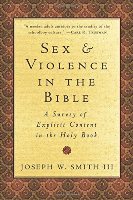It’s certainly an unusual book, and it’s also a title that will catch your attention – Sex and Violence in the Bible: A Survey of Explicit Content in the Holy Book. Coming to us from a trusted publisher we wanted to check it out, and today we have the author with us to talk about his unique work.
Joseph W. Smith III is a teacher, journalist, author and discussion leader in Central Pennsylvania. He holds a BA from Syracuse and a master’s from NYU.
After working as a copy editor for Simon & Schuster in the 1980s, he moved into public education, and has taught high school English for nearly 25 years. He has been a part-time film critic for the Williamsport Sun-Gazette, since 1997. In addition to Sex and Violence in the Bible, Smith also wrote a book-length study of Hitchcock’s Psycho, published by McFarland in 2009.
For the past 20 years, he has served as elder, clerk and adult Sunday school teacher at New Life Presbyterian Church in Montoursville, Pa. He has been married since 1986 to Dr. Mona P. Chang, a family physician, and they have two children — Douglas (b. 1989) and Tim (b. 1992).
Books At a Glance (Fred Zaspel):
This is such an unusual book – how did it come about? What gave you the idea?
Smith:
My initial inspiration was a nifty little appendix in Brian Godawa’s excellent book Hollywood Worldviews (I stole the title of his appendix for my own book, btw). His point was that the Bible has plenty of this material, sometimes fairly explicit; I simply wanted to expand on Brian’s work by looking at ALL the relevant passages — hundreds of them, as it turned out. In doing so, I hoped Scripture could serve as our guide for “how much is too much” – since nearly every Christian has to ask this question in daily encounters with secular culture.
 Books At a Glance:
Books At a Glance:
What is the purpose of your book, and what contribution do you hope to make?
Smith:
In addition to what I described above, I hope my work will serve as a sort of reference on these passages – especially since we rarely hear sermons on such topics as Eglon’s ghastly murder in Jdg. 3, the bride’s lovely body in Song 7 or the infamous Ezek. 23:20. For anyone wondering, “Whoa – does the passage really say that?” – this book will answer that question. I hope it will also show that sex and violence, despite their occasional awkwardness, are not beyond the purview of Christ and His word. As Abraham Kuyper put it, “There is not a square inch in the whole domain of existence over which Christ does not cry, Mine!”
Books At a Glance:
Looking back on what you learned from your research, what stands out in your mind as most surprising? Or perhaps most challenging to your own thinking?
Smith:
To be honest, at first I came roaring into this project with a sort of youthful iconoclasm, ready to show that the Bible really packed a whammy when it came to sex and violence. What I learned almost at once was: Despite a generous handful of very explicit material, the vast majority of Scripture is quite tasteful and reticent in this regard – often preferring idiom and euphemism to direct statement. For instance, the actual Hebrew word for “sexual intercourse” is extremely rare, occurring in only four OT passages; dozens of others use an indirect term such as “know,” “lie with” or “go in to” (as in, “going into the tent”).
 Books At a Glance:
Books At a Glance:
What general observations can you share with us about how the biblical writers themselves report such explicit topics like sex and violence.
Smith:
I’ve commented on this above, of course – but I would also like to mention that even with its exhaustive nature, my book quotes only 700 verses or so. That’s about 2% of the entire Bible – a far smaller percentage of graphic material than one might find in, say, a Stephen King novel or a Tarantino film.
Books At a Glance:
As a close follow-up to that, what might this have to say, 1) to our culture that tends in conversation and film to make so much of sex and violence, and 2) to preachers who must treat these passages in mixed, public settings?
Smith:
I think I can answer both of those questions by urging Christians to adopt a truly Scriptural attitude toward sex and violence – namely, that they are important; they need to be addressed – often quite specifically; that we needn’t be squeamish, since the Bible is often perfectly frank about (for example) incest, nocturnal emission, menstruation, vomit, decapitation, rape and dismemberment (all subjects covered in my book!). BUT – we are not to be obsessed with these subjects like so much modern culture, which often seems intent on showing and flaunting as much as possible.
As I suggest in my afterword, the remedy or antidote to this cultural depravity is not to ignore the subjects at hand – which in some strange way only feeds the obsession, like a person on a diet who never eats; clearly s/he still has an obsession with food. Rather, we must handle these topics frankly and with a level head – like the parent who has to talk to a child about sex; much better to discuss it plainly than pretend it isn’t there, as we seem to do with certain passages of Scripture. I wrote the book to show that Scripture surely deals with these things – and to show how it deals with them, so that we can learn how to deal with them too.

